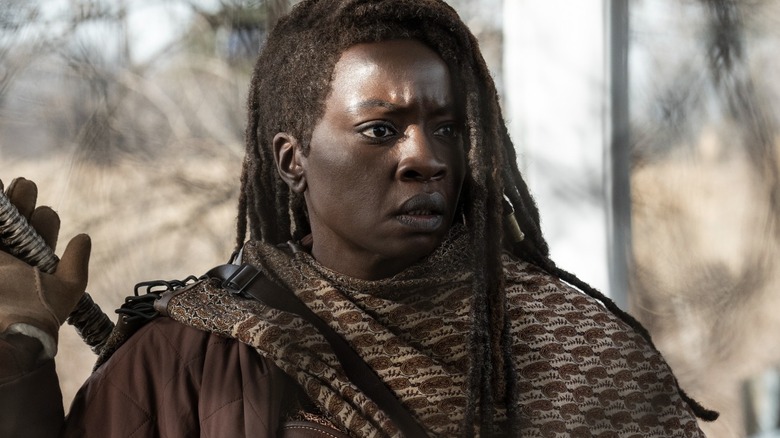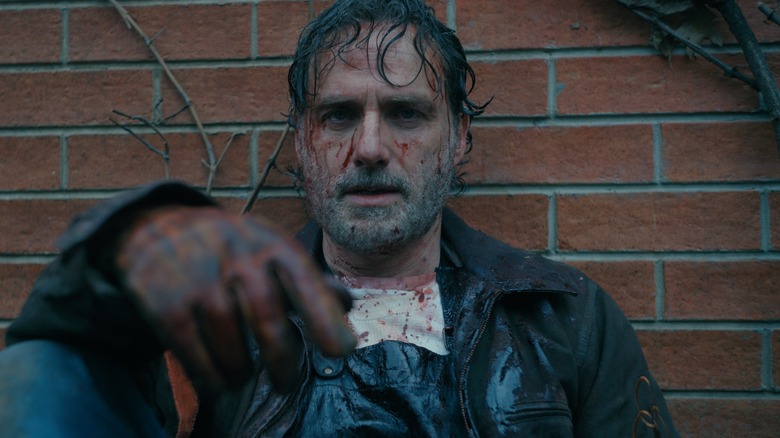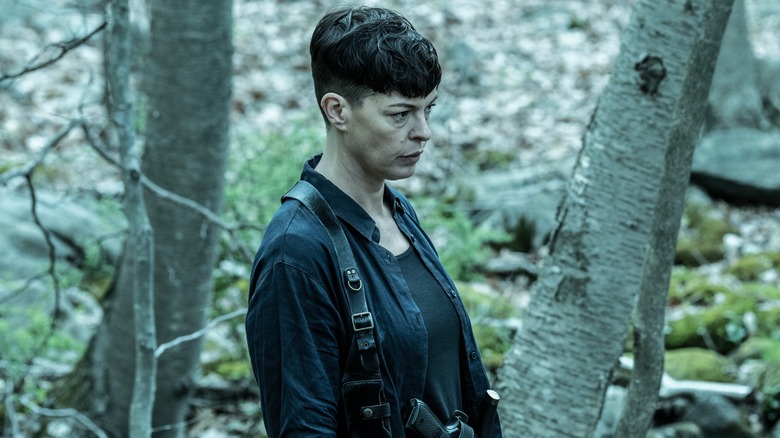Where Does The Ones Who Live Exist On The Walking Dead Timeline
AMC's "Walking Dead" universe remains in a state of rapid expansion, with one of the most highly-anticipated installments to date right around the corner from its debut. "The Walking Dead: The Ones Who Live" puts the spotlight on franchise staples Rick Grimes (Andrew Lincoln) and Michonne (Danai Gurira) in their desperate fight to reunite after years apart. The program's first full trailer has hit the Internet, and it promises action, intrigue, emotion, and, naturally, plenty of zombies. That's all well and good, but how does this story fit into the overall "Walking Dead" timeline?
Thankfully, the "Walking Dead" timeline isn't too difficult to understand. Season 1 of the original series is set roughly in 2010, which is the same year it arrived on the airwaves. As revealed on "Fear the Walking Dead," the zombie outbreak begins shortly before the first "Walking Dead" title begins. By the time it concludes, 11 seasons and multiple time jumps later, it's knee-deep into the 2020s. Another series, "The Walking Dead: Dead City," picks up years after the original show's finale, placing it close to the 2030s. Thus, it can be inferred that "The Ones Who Live" is set between the end of "The Walking Dead" and the start of "Dead City," as implied by Rick and Michonne's scenes in the finale. He's shown attempting to escape the Civic Republic as she rides off on horseback to find him.
Considering how long the outbreak has been going on by the time of "The Ones Who Live," it only makes sense that some of the zombies themselves have physically changed to reflect this.
The walkers themselves reflect the time elapsed between the start of the apocalypse and The Ones Who Live
In newer pieces of "Walking Dead" media, including "The Walking Dead: The Ones Who Live," there are numerous signs that the apocalypse has been underway for some time. Most notably, large-scale survivor civilizations such as the Commonwealth and the aforementioned Civic Republic have formed, thus creating new political systems as they interact, cooperate, and clash with one another. Additionally, through the zombies themselves, it becomes apparent that the outbreak is far from a recent event.
Though it largely focuses on Rick Grimes and Michonne, the "Ones Who Live" trailer briefly shines a spotlight on some walkers. Many look as menacing and rotted as ever, though there are a handful that take the creepiness factor to the next level. What remains of their skin hangs loosely, their eyes are sunken in, and they move slowly toward their potential victims. These seem to be the individuals who were infected and became walkers early on in the apocalypse. They've managed to exist for years upon years without being killed by survivors, so their bodies have undergone extensive decomposition. Thus, they appear less "fresh" than many of their fellow zombies.
While this is a great signifier for the timeline placement of "The Ones Who Live," it's fair to wonder how these zombies are still able to wander the Earth — especially when looking at the "Walking Dead" universe through a real-world scientific lens.
How are some of the earliest walkers still around during The Ones Who Live?
In reality, it doesn't take very long for a human body to decompose entirely. Within a day or so of death, internal organs begin to erode, and a mere few days later, the body will bloat. Over a week after death, blood decomposes; multiple weeks later, teeth and nails will fall out; and by a month, the body will begin to liquefy. That wouldn't leave someone infected with a zombie virus much time to wreak havoc, especially not for 11 seasons of television and multiple spin-offs set across over a decade.
The secret to how some of the earliest walkers are still present during "The Walking Dead: The Ones Who Live" boils down to the zombie virus itself. Known as the Wildfire Virus, the disease burst onto the scene in 2010 and swiftly became a major threat worldwide. It takes hold once an individual loses all bodily functions, reactivating the hindbrain — the portion of the brain responsible for basic functions — turning them into a mindless, animalistic, flesh-hungry walker. It's also capable of slowing the decaying process, hence why there are still-decomposing walkers that turned many years ago on "The Ones Who Live."
"The Walking Dead: The Ones Who Live" arrives on AMC and the AMC+ streaming service on February 25.


